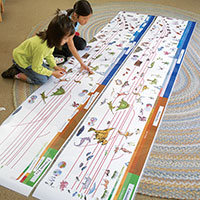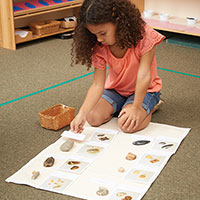
"I care about climate justice and the living planet... I've learned you are never too small to make a difference."
—Greta Thunberg1
 When I present the Timeline of Life to elementary students, discussing how life began on Earth, I enjoy pointing out my favorite illustrations: the Ice Ages, the Carboniferous Period when dead plants turned into coal, the amazing animals and insects. "These butterflies were two feet wide when Earth had much more oxygen!" I exclaim, then watch the children's eyes grow wide as they take in this fascinating information.
When I present the Timeline of Life to elementary students, discussing how life began on Earth, I enjoy pointing out my favorite illustrations: the Ice Ages, the Carboniferous Period when dead plants turned into coal, the amazing animals and insects. "These butterflies were two feet wide when Earth had much more oxygen!" I exclaim, then watch the children's eyes grow wide as they take in this fascinating information.
One time, after receiving this great lesson, a girl sat transfixed in front of the timeline. Beginning with the Kingdom of Trilobites, she traced each red line, representing the trajectory of the lifespan of a species. The lines begin at the bottom of the chart, move upwards to a crescendo and then often begin to decline, back to the bottom of the chart. "They went extinct. They went extinct, " she murmured over and over as she came to the end of each line. Finally, she turned to me and asked, "Will humans go extinct, too?"
Many elementary Montessori teachers have been asked similar profound questions. Since we're trained to empower children to do their own research and discover for themselves, we usually avoid giving answers. Sometimes, however, we need to address misconceptions children may have. For example, you might clarify the vast amount of time this timeline represents. Children are grateful for opportunities to share their concerns, even when we don't have all of the answers. We can say, "I wonder about that, too. How do you feel about it?"
"We want so much to protect our children (and ourselves) that we often remain silent about our pain for the world and the threats to the web of life that evoke that pain."
—Joanna Macy2
How can we meet children's needs for safety and security and also address the concerns of children who may feel uneasy about world news? It's a difficult decision for many parents and teachers—we don't want to overwhelm children with more than they can handle. Don't give children more information than they ask for. When they want more, they will ask you.
Recent studies show that children often know a lot more about what's happening in the world than we think they do. In her book, Coming Back to Life, Joanna Macy devotes a chapter on how to discuss difficult issues with children. Here are some of her practical suggestions for engendering hope and empowerment:
When we act on behalf of our communities and our world, we feel empowered. Children find hope in taking action by raising money for disaster relief, writing letters to their elected officials, cleaning up parks, and participating in purposeful community events.
In her book, Macy includes stories, games, gratitude practices, and nature-related activities. "The Web of Life, " for example, is a simple game that dramatizes our interconnectedness. A ball of yarn is tossed from child to child in the circle, each looping the yarn around their own wrist before tossing it to the next person, demonstrating how we are all connected in this symbolic web of life. Children can then discuss, draw, or write about their experience.
Montessori noted that the elementary years are a time of "hero worship." We can encourage students to do research about courageous people, young and old, who have made a difference in the world. Discuss the big names such as Rosa Parks, Martin Luther King, and Gandhi, as well as lesser-known heroes like Black Elk, Dorothy Day, and Lily Yeh.
Children are inspired to learn about the youngest heroes: nine-year-old Ridhima Pandey, an environmental activist from India, and Malala Yousafzai, who continues her brave fight for educational rights for girls in Pakistan.
 Elementary-age children are naturally interested in issues of fairness and social justice. Teachers can play an important role by encouraging global citizenship, understanding, and respect for diversity. Cheryl Duckworth, professor of Conflict Resolution, explains, "These values in Montessori education are every bit as crucial as the subjects of math, language, or science."3
Elementary-age children are naturally interested in issues of fairness and social justice. Teachers can play an important role by encouraging global citizenship, understanding, and respect for diversity. Cheryl Duckworth, professor of Conflict Resolution, explains, "These values in Montessori education are every bit as crucial as the subjects of math, language, or science."3
Older children enjoy debating issues of fairness that arise in their classroom, and what they learn about in the wider world. With guidance, children can learn how to lead class meetings and practice interpersonal skills such as listening to others and respecting everyone's opinions.
As a teacher you can:
Dr. Timothy J. Purnell, CEO of the American Montessori Society, wrote, "We are a community that values peace and social justice, equity and inclusion... [and] we stand with you as you build a world that is more inclusive and just." 4
If Montessori's dream of uniting all of humanity is to be realized, our work as teachers is crucial. Perhaps now, more than ever, the children we help and guide are our hope for humanity.
"Our generation's calling is clear: to create a thriving, just, sustainable world that works for all, we must take bold and systemic action to transform our whole society."
—Joshua Gorman, founder of Generation Waking Up5
Footnotes:
1. Thunberg, Greta, Swedish teenage climate activist, 2018
2. Macy, Joanna, 2014, Coming Back to Life: Practices to Reconnect Our Lives, Our World
3. Duckworth, Cheryl, 2008
4. Purnell, Timothy J., 2019
5. Gorman, Joshua, 2014
The author of this article, Irene Baker, welcomes comments and feedback: ibaker@montessoriservices.com
—by Irene Baker, MEd, Montessori Educational Consultant at Montessori Services. She holds both primary (ages 3-6) and elementary (ages 6-12) Montessori certifications and has taught at all three levels. For over 20 years, she has served as a Montessori consultant and teacher-trainer for primary and elementary levels, and has presented workshops for teachers at schools and AMS conferences. Her work with students and teachers is infused with her passions: storytelling, history, social justice, non-violent (compassionate) communication, poetry, meditation, music, and the natural world.
—Originally Published 2019